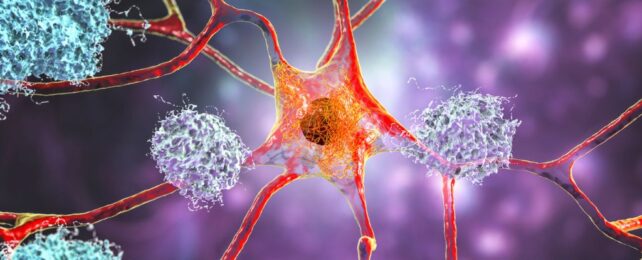Scientists have identified the exact point at which healthy brain proteins are shocked into the tangled mess that is commonly associated with Alzheimer's disease.
Researchers at the University of California Santa Barbara (UCSB) are hopeful that the new laboratory technique behind the discovery can be used to directly study the 'never-before-seen' early stages of many neurodegenerative diseases.
Tau proteins are abundant in the human brain. At first, these proteins look like tiny pieces of string inside neurons. As they fold and bind together with structural elements called microtubules, however, they create a sort of skeleton for brain cells that helps them function properly.
Unfortunately, this folding of tau can sometimes go awry. Abnormally tangled tau proteins are a sign of many, although not all, cases of Alzheimer's.
In this knotted-up state, known as a neurofibrillary tangle, tau proteins are suspected to smother neurons from the inside out, interfering with cell function and ultimately leading to cell death.
Other experts argue that tau tangles aren't toxic at all, but actually protective in nature, produced in response to some other underlying issue.
Being able to watch tau as it tangles in the lab could help researchers clarify the protein's role in brain degeneration. It could also be a great model on which to test up-and-coming treatments.
An interdisciplinary team of scientists at UCSB have now proposed a way to do just that.
With slightly less than a volt of electricity, researchers have shown they can trigger out-of-control tangling among a specific type of tau protein.
This current was designed to mimic the molecular signals that naturally cause 'hyper-folding' of tau proteins in the brain, allowing researchers to watch in real time as tau proteins pass a critical 'tipping point' and shift from healthy to diseased states .
When this line is crossed, tangles are rapidly formed.
"This method provides scientists a new means to trigger and simultaneously observe the dynamic changes in the protein as it transitions from good to bad," explains biochemist Daniel Morse from UCSB.
"Because we can turn on and fine-tune the process at will, we can use this system to see what molecules could interdict or block specific stages of folding and assembly."
Tau proteins include a group of several soluble variants, but the one used in the current study is called K18, a core peptide containing the microtubule binding domain.
Interestingly, the researchers found that when K18 was exposed to a volt of electricity over a long period of time (for hours or days), it led to rapid and irreversible tangling.
Yet even with just 15 minutes of brief exposure, tau proteins began to assemble into knots, albeit ones that were easier to untangle with a reverse voltage.
This might be a sign that tau tangling can progress over time, just as the symptoms of Alzheimer's seem to do.
The transition from a healthy to diseased tau protein, researchers write, could be "a gradual one rather than the result of a single all-or-none switch."
That's an interesting insight into K18, but there are numerous other forms of tau that are sometimes associated with Alzheimer's disease.
The way these other proteins fold and assemble and the repercussions that has on cell activity can now, theoretically, be studied using similar techniques.
The study was published in the Journal of Biological Chemistry.
